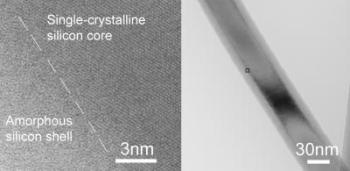Harvard and Berkeley researchers have witnessed a drastic improvement in the sensitivity and efficiency of silicon-coated nanowires.
 Coated Nanowire
Coated Nanowire
The results, published in Nano Letters, show that these coated nanowires could prove suitable for a range of applications, including photodetectors and solar cells.
Owing to a high surface-to-volume ratio, nanowires feature a high surface recombination rate. As a result, the photogenerated charges recombine instead of getting deposited at the terminals. The carrier time taken by a simple nanowire is reduced by four to five times in magnitude, thus affecting the efficiency of material in applications such as solar cells.
Associate Professor of Electrical Engineering at the Harvard School of Engineering and Applied Sciences (SEAS), Kenneth Crozier, worked with his coworkers to devise a promising solution. The team made accurate measurements on nanowires coated with a layer of amorphous silicon to reveal a drastic decrease in the surface recombination.
Surface passivation was utilized to improve silicon chips efficiency. But, researchers have not experimented much with surface passivation of nanowires. During the creation of a collection of single-crystal silicon nanowires, the researchers discovered that tiny particles of gold used to form the nanowires were used up. Hence, they predict that the amorphous silicon coating was collected on each nanowire.
Crozier and his research team made a decision to test the collection of silicon nanowires. Scanning photocurrent studies demonstrated a hundred-fold decrease in surface recombination. On the whole, the coated wires featured a 90-fold improvement in photosensitivity than uncoated nanowires.
Co-author Yaping Dan claims that the increase in efficiency is due to the fact that the coating extends the broken atom bonds at the silicon surface. Moreover, the coating may result in a high-electric potential barrier, which restricts the movement of the photo-generated charge carriers within the single-crystalline silicon. In view of improved carrier lifetime of nanowires, the researchers estimate that the nanowires will offer high-energy conversion efficiency in solar cells.